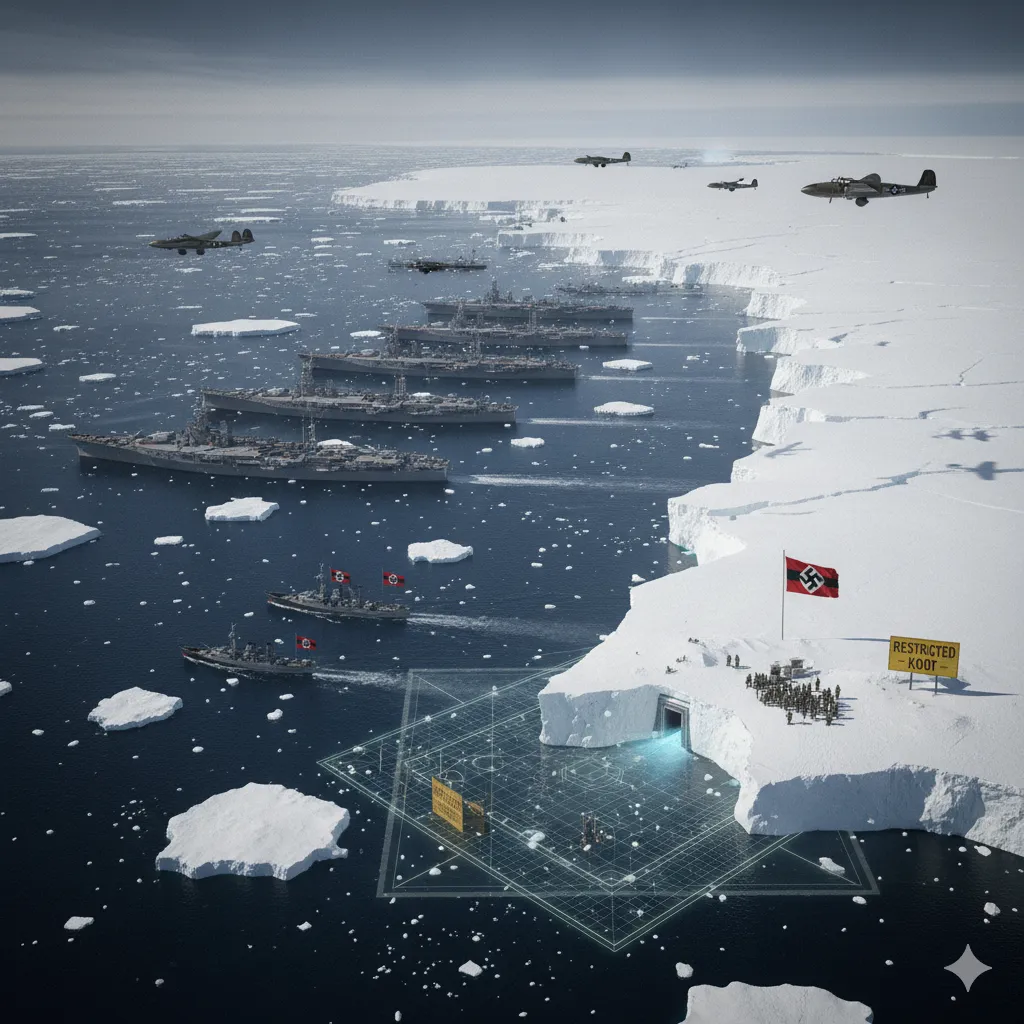
Antarctica: The Frozen Tomb of Forgotten Empires
←Return to ArchivesIn 1946, the United States launched the largest military expedition to Antarctica in history. Operation High Jump. Led by Admiral Richard Byrd, it involved over 4,000 personnel, 13 ships, and multiple aircraft. The official mission was to test cold-weather equipment and conduct scientific research.
The mission lasted less than three months. It was supposed to last six.
What happened down there?
According to declassified documents, the expedition mapped coastlines, conducted geological surveys, and established research stations. But according to conspiracy theorists, something else occurred. Contact with an advanced civilization living beneath the ice. A confrontation. Losses. A forced retreat.
The rumors were fueled by Admiral Byrd himself. In interviews after the mission, he made cryptic statements about Antarctica being the most important place for science and the future of the nation. He spoke of vast untapped resources. Mysteries waiting to be uncovered.
But he never mentioned underground civilizations. Never spoke of lost technology or extraterrestrial contact. Those claims came later, from authors selling books and researchers chasing clicks.
The truth about Operation High Jump remains classified in part. But the mystery it created has never faded.
And it was not the first expedition to Antarctica that raised questions.
In 1938, Nazi Germany sent an expedition to the southern continent. Officially, they were mapping territory and claiming resources. Whaling stations. Strategic positions. Preparations for war.
But some believe the Nazis were searching for something else. Ancient technology. Entryways to subterranean realms. A base for secret weapons development.
After World War II, rumors spread that high-ranking Nazi officials had fled to Antarctica, hiding advanced prototypes and classified research in hidden bunkers beneath the ice. Some claimed Hitler himself escaped to South America via a secret Antarctic base.
No concrete evidence has ever been found. But the rumors persisted. And when the United States sent thousands of troops to Antarctica immediately after the war, people asked why.
Was it scientific curiosity? Or were they hunting something the Nazis left behind?
In 1959, twelve nations signed the Antarctic Treaty, effectively banning military activity, nuclear testing, and territorial claims on the continent. On paper, it was an agreement to preserve Antarctica for peaceful scientific research and environmental protection.
But to conspiracy theorists, it was a cover-up. A way to control access. To prevent civilians from discovering what was really down there.
Because the treaty did more than ban military operations. It restricted unauthorized travel. Enforced no-fly zones over certain regions. Created an international framework where information was shared only among select governments.
And once the treaty was in place, Antarctica became the most isolated, most restricted, and most heavily monitored place on Earth.
Satellite images from recent decades have only deepened the mystery. Strange formations beneath the ice. Geometric patterns. Structures that appear artificial. Anomalies that do not match natural geology.
Skeptics argue these are simply ice formations, shadows, and pareidolia. The human brain seeing patterns where none exist.
But others point to the data. Radar scans revealing massive caverns beneath the ice. Temperature readings showing areas of unusual warmth. Seismic activity inconsistent with tectonic models.
And then there are the eyewitness accounts. Scientists stationed at remote Antarctic bases reporting strange lights in the sky. Unexplained disappearances. Equipment malfunctions with no logical cause.
Most of these reports are dismissed as isolation-induced paranoia. The psychological effects of spending months in one of the harshest environments on the planet.
But some researchers believe there is more to it. That Antarctica is not just a frozen wasteland. That beneath the ice, there are secrets. Ancient ruins. Advanced technology. Perhaps even life.
The problem is access. The ice is miles thick. The cold is lethal. The terrain is unforgiving. And the international treaty ensures that any major discoveries are controlled by governments, not independent researchers.
So the questions remain unanswered. What did the Nazis find? What did Operation High Jump encounter? Why is Antarctica so heavily restricted?
And most importantly, what is really buried beneath the ice?
The age of exploration is over. The age of secrecy has begun. And the frozen continent remains locked, waiting for the ice to melt or for someone to break through and reveal what has been hidden for so long.